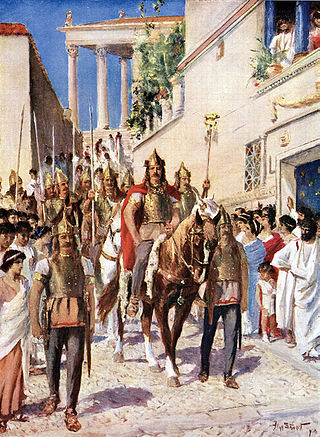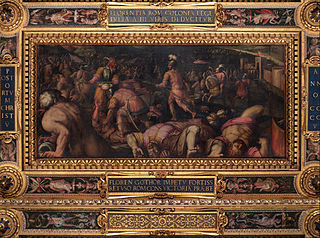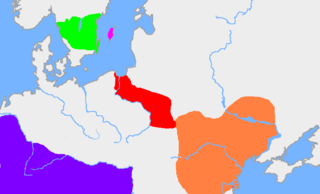Fate of Odotheus' People
In 399, Tribigild, a Gothic commander in Roman service who led a unit of these Phrygian survivors of Odotheus' kingdom, [8] rose in revolt. Michael Kulikowski suggests the Goths of Tribigild were in fact survivors of the massacres in Asia Minor of 378/9, after the Battle of Adrianople. [9] Gainas, another Gothic general sent to suppress him, suborned Tribigild's revolt for his own purposes. After some initial successes, Gainas was suppressed and fled north of the Danube, only to be killed by the Hunnic chieftain Uldin. [10] Thus perished many of Odotheus' remaining people; the fate of the rest in Phrygia is unknown.
The Greuthungi's settlement in Phrygia facilitated the so-called Gothicization of the Danubian provinces and, later, Asia Minor. [5]

Alaric I was the first king of the Visigoths, from 395 to 410. He rose to leadership of the Goths who came to occupy Moesia—territory acquired a couple of decades earlier by a combined force of Goths and Alans after the Battle of Adrianople.

The Goths were Germanic people who played a major role in the fall of the Western Roman Empire and the emergence of medieval Europe.

The Ostrogoths were a Roman-era Germanic people. In the 5th century, they followed the Visigoths in creating one of the two great Gothic kingdoms within the Roman Empire, based upon the large Gothic populations who had settled in the Balkans in the 4th century, having crossed the Lower Danube. While the Visigoths had formed under the leadership of Alaric I, the new Ostrogothic political entity which came to rule Italy was formed in the Balkans under the influence of the Amal dynasty, the family of Theodoric the Great.
Fritigern was a Thervingian Gothic chieftain whose decisive victory at Adrianople during the Gothic War (376–382) led to favourable terms for the Goths when peace was made with Gratian and Theodosius I in 382.

Stilicho was a military commander in the Roman army who, for a time, became the most powerful man in the Western Roman Empire. He was of Vandal origins and married to Serena, the niece of emperor Theodosius I. He became guardian for the underage Honorius. After nine years of struggle against barbarian and Roman enemies, political and military disasters finally allowed his enemies in the court of Honorius to remove him from power. His fall culminated in his arrest and execution in 408.
Flavius Fravitta was a leader of the Goths and a top-ranking officer in the army of the Eastern Roman Empire.
Alatheus and Saphrax were Greuthungi chieftains who served as co-regents for Vithericus, son and heir of the Gothic king Vithimiris.

Radagaisus was a Gothic king who led an invasion of Roman Italy in late 405 and the first half of 406. A committed pagan, Radagaisus evidently planned to sacrifice the Senators of the Christian Roman Empire to the gods, and to burn Rome to the ground. Radagaisus was executed after being defeated by the general Stilicho. 12,000 of his higher-status fighters were drafted into the Roman army and some of the remaining followers were dispersed, while so many of the others were sold into slavery that the slave market briefly collapsed. These Goths later joined Alaric I in his conquest of Rome in 410.

The sack of Rome on 24 August 410 AD was undertaken by the Visigoths led by their king, Alaric. At that time, Rome was no longer the capital of the Western Roman Empire, having been replaced in that position first by Mediolanum in 286 and then by Ravenna in 402. Nevertheless, the city of Rome retained a paramount position as "the eternal city" and a spiritual center of the Empire. This was the first time in almost 800 years that Rome had fallen to a foreign enemy, and the sack was a major shock to contemporaries, friends and foes of the Empire alike.

Between 376 and 382 the Goths fought against the Eastern Roman Empire, one of several Gothic Wars in Roman history. This conflict included a catastrophic Roman defeat at the Battle of Adrianople, and is commonly seen as a part— albeit a part of disputed significance— of the century of events leading to the Fall of the Western Roman Empire.

Uldin, also spelled Huldin is the first ruler of the Huns whose historicity is undisputed.
Gainas was a Gothic leader who served the Eastern Roman Empire as magister militum during the reigns of Theodosius I and Arcadius.
Tribigild, also called Tarbigilus was an Ostrogothic general whose rebellion against the Eastern Roman Empire precipitated a major political crisis during the reign of Emperor Arcadius.
The Thervingi, Tervingi, or Teruingi were a Gothic people of the plains north of the Lower Danube and west of the Dniester River in the 3rd and the 4th centuries.
The Goths, Gepids, Vandals, and Burgundians were East Germanic groups who appear in Roman records in late antiquity. At times these groups warred against or allied with the Roman Empire, the Huns, and various Germanic tribes.

The Greuthungi were a Gothic people who lived on the Pontic steppe between the Dniester and Don rivers in what is now Ukraine, in the 3rd and the 4th centuries. They had close contacts with the Tervingi, another Gothic people, who lived west of the Dniester River. To the east of the Greuthungi, living near the Don river, were the Alans.
Flavius Promotus was a Roman general who served under Theodosius I until his death in 391 AD. In 386 he had a command in Africa, and was magister peditum for Thrace. In 388 he was made magister equitum, and the following year was consul. He was killed in an ambush organised by Rufinus, a rival for Theodosius' favour.
The history of the Huns spans the time from before their first secure recorded appearance in Europe around 370 AD to after the disintegration of their empire around 469. The Huns likely entered Western Asia shortly before 370 from Central Asia: they first conquered the Goths and the Alans, pushing a number of tribes to seek refuge within the Roman Empire. In the following years, the Huns conquered most of the Germanic and Scythian tribes outside of the borders of the Roman Empire. They also launched invasions of both the Asian provinces of Rome and the Sasanian Empire in 375. Under Uldin, the first Hunnic ruler named in contemporary sources, the Huns launched a first unsuccessful large-scale raid into the Eastern Roman Empire in Europe in 408. From the 420s, the Huns were led by the brothers Octar and Ruga, who both cooperated with and threatened the Romans. Upon Ruga's death in 435, his nephews Bleda and Attila became the new rulers of the Huns, and launched a successful raid into the Eastern Roman Empire before making peace and securing an annual tribute and trading raids under the Treaty of Margus. Attila appears to have killed his brother and became sole ruler of the Huns in 445. He would go on to rule for the next eight years, launching a devastating raid on the Eastern Roman Empire in 447, followed by an invasion of Gaul in 451. Attila is traditionally held to have been defeated in Gaul at the Battle of the Catalaunian Fields, however some scholars hold the battle to have been a draw or Hunnic victory. The following year, the Huns invaded Italy and encountered no serious resistance before turning back.

The Gothic War (401-403) was a war between the Western Roman Empire and the Visigoths. The commander of the Roman army was Flavius Stilicho, the Visigoths were led by Alaric. The war was fought in the north of Italy and, in addition to a number of small fights, consisted of two major battles, both of which were won by the Romans.

The Gothic Revolt of Tribigild was a revolt in 399-400 of the Goths in Anatolia that caused a major political crisis during the reign of Emperor Arcadius (395-408). The uprising was led by Tribigild, leader of a unit of Goths within the Roman army. Initially, the uprising only took place in Anatolia, but after the commander-in-chief of the Eastern Roman army Gainas intervened and sided with the Goths, it became a threat to the unity within the Eastern empire.










